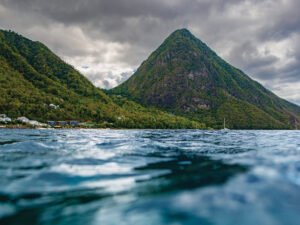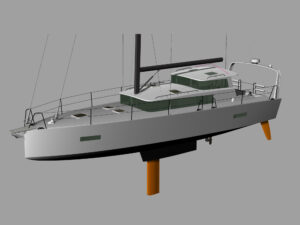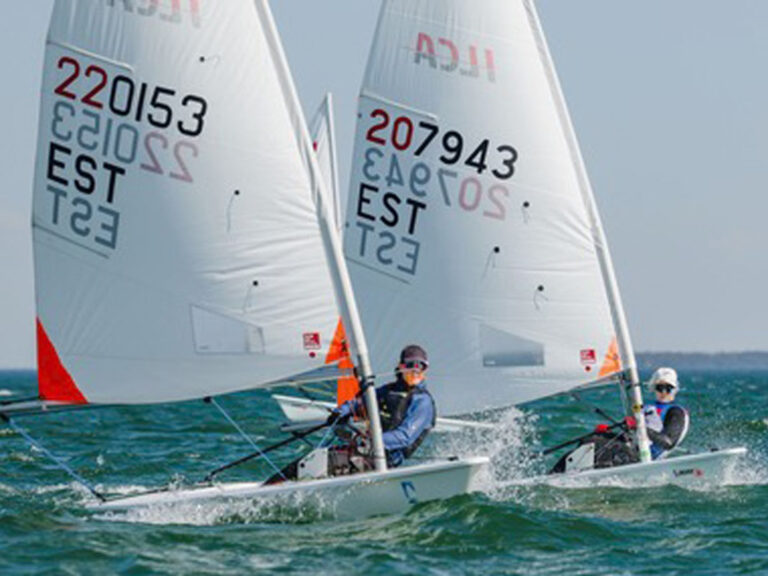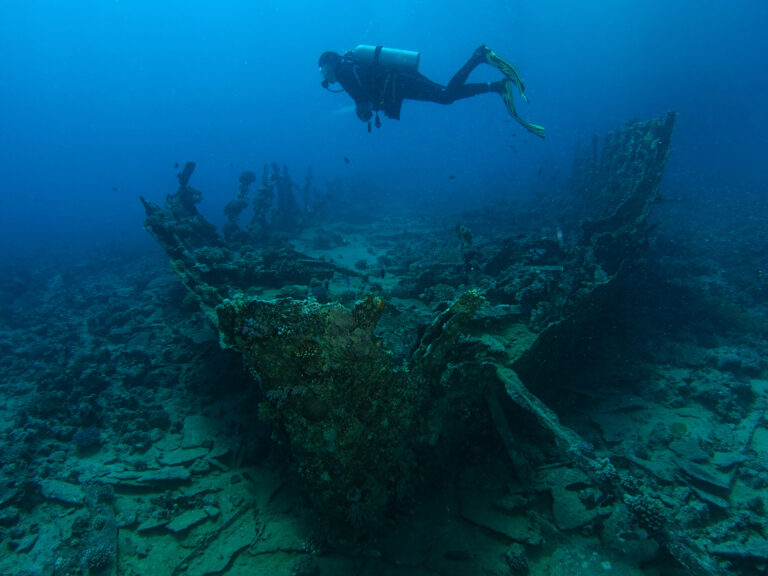
Silent Maid
It was on the third leg of the Opera House Cup Regatta, held off Nantucket, Massachusetts, that I saw Silent Maid for the first time. I was steering a vintage, 1930s-era 30-square-meter sloop named Cythera, and I watched as this magnificent, varnished, 33-foot catboat barreled straight downwind not far from us. The mainsail was eased all the way out, the mast and the gaff made a graceful arc, and the boat was heeled slightly to windward. Silent Maid looked powerful and purposeful. Paraphrasing the baseball Hall-of-Famer and amateur philosopher Yogi Berra, Silent Maid “was even better looking than she looked.”
At a raucous prize-giving ceremony on one of Nantucket’s great beaches later that night, I bumped into Peter Kellogg, who’d commissioned the new Silent Maid to be built to her original lines. Silent Maid was the only catboat in the regatta and finished a respectable 13th out of 57 boats. The boat also earned the Gwen Gaillard Spirit of the Race Award. Kellogg dressed up for the ceremonies by wearing a wooden bow tie—a tribute, I guess, to his love of wooden vessels.
Kellogg has restored a 19th-century 24-foot B Cat named Myth, now on display at the Independence Seaport Museum in Philadelphia, Pennsylvania, and he’s built a series of wooden boats, including a few A Cats for racing on Barnegat Bay, New Jersey, and the Sandbaggers Bull and Bear. Bull and Bear are well named—Kellogg is retired from a successful career on Wall Street. When he and his wife, Cynthia, have time, they’ve cruised Silent Maid on Chesapeake Bay.
The Independence Seaport Museum was the platform for Silent Maid‘s construction. A crew led by master boatbuilder John Brady hand-crafted the vessel from mahogany, white oak, and Spanish cedar. The boat was christened and launched in June 2009.
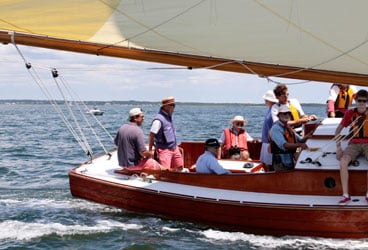
| |Sporting a straw boater, Silent Maid owner Peter Kellogg helms during the Padanaram Catboat Rendezvous. Photo by Peter Corbin. |
During the summer of 2010, Kellogg and his crew took Silent Maid on a goodwill tour of boat shows, regattas, and yacht-club events along the U.S. East Coast. At the famed Eggemoggin Reach Regatta in Brooklin, Maine, Silent Maid placed first overall out of 92 boats, a victory that gained her a wealth of attention.
Knowing this, and then seeing her out on the water, I couldn’t resist hinting to Kellogg at the Opera House party that it would be fun to sail her some time. About six months later, a brief email arrived, inviting me to the Squan Tri-Sail Regatta in New Jersey at the end of July 2011. I was available—and eager. Before the regatta, I unearthed the history of this and some other marine masterpieces.
The original Silent Maid was commissioned in 1924 by Edwin Schoettle. A worshiper of catboats who was a famous sailor and author from Island Heights, New Jersey, Schoettle in 1928 published and edited an anthology called Sailing Craft, for which he also wrote a chapter—devoted to catboats, of course. It’s one of the most important books on American small yachts ever published. Schoettle also owned a powerboat to tow his catboat to regattas, which he playfully named_ Noisy Lady_. Schoettle’s boat names set me to wondering about the inspiration for the complementary names of his sailboat and his powerboat.
From Cargo Carriers to Cup Winners
The catboats of Barnegat Bay were used in the middle of the 19th century to move cargo and people around before there were many roads in the surrounding area. Inspired by the America’s Cup races that took place in New York Harbor in 1870, a group of Barnegat Bay sailors started their own race in catboats the following summer. The group commissioned Tiffany & Co. in New York City to create a suitable trophy for the race, then called it the Toms River Challenge Cup. The cost of the silver cup at the time was $175; today, it would cost more than $3,000.
That trophy is still in play today, and Kellogg had told me that the original Silent Maid was built to race for it. Schoettle’s naval architect of choice for the project was Francis Sweisguth, who, a few years earlier, had designed the race-winning catboat Scat II for him.
During her early years,_ Silent Maid_ raced under a time-allowance rating against the other catboats on Barnegat Bay. She won the B Cat Barnegat Championship in 1925, 1926, and 1927, but she never won the Challenge Cup. According to the record books, the A Cats won each year in the 1920s.
_
Silent Maid_, with an LOA of 33 feet and a beam of 12 feet 6 inches, was bigger than most of the other catboats; she carried 950 square feet of sail area and had a huge cabin that slept four comfortably. The cabin had 6 feet of headroom, a galley, and a head, and there was also an innovative self-bailing cockpit.
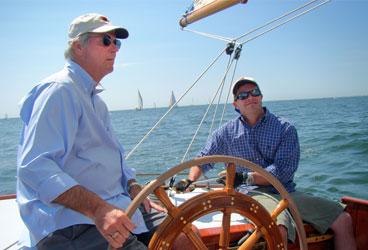
| |The author takes a trick at the wheel. Photo courtesy of Craig McLean.|
The boat was equally capable as a cruiser or racer. In the chapter “American Catboats,” Schoettle describes his beloved Silent Maid: “This class of catboat represents one of the roomiest, safest, and easiest sailed boats of present-day yachts,” he writes. “It is, without question, the best for use in America or anywhere else on inland bodies of water. [Most of] the boats I have owned and sailed for years were designed by my friend Francis Sweisguth. While his work for me has been confined to boats of small size, it is nevertheless to his credit to say, as a token of his versatility, that to do large and small craft equally well is an accomplishment he has reason to be proud of.” Schoettle goes on to pinpoint the source of his affinity for catboats: “This type of boat has only one sail, and there must be perfect harmony between sail and hull,” he writes.
And he was unabashed in his praise for Sweisguth. “Francis made an exhaustive search of the details concerning all famous boats,” Schoettle writes. “Silent Maid is the composite result of this work.”
Yet another intriguing dimension of this story is Kellogg’s devotion to bringing the classics, including catboats, back to life. “Silent Maid was here on Barnegat Bay my whole life,” Kellogg had told me. “My father actually owned her briefly. I had some other catboats, but this was the mother of all catboats. The old one was in bad shape, so new construction was needed. Brady has built over 200 feet of wooden boats for me so far.”
So far, I noted to myself. Builder Brady is understandably a busy man—he also led the conservation of the first Silent Maid, which is now a display piece also at Philadelphia’s Independence Seaport Museum, where she’s preserved with her history intact.
Kellogg has also lent the Sandbaggers Bull and Bear to the National Sailing Hall of Fame in Annapolis, Maryland, for the past two summers. “Over 1,400 people have had a chance to sail on one of these classics,” he said. “Many of them have been first-time sailors.” The Sandbaggers earned their name via the sandbags used as movable ballast during racing to replicate cargo from their early days. Today Bull and Bear, powerful skiffs, use water bags and crew for ballast and extra stability.
A Class of Beautiful Classics
I warmed up for my weekend on Silent Maid by racing on a 28-foot A Cat in the weekly Barnegat Bay Yacht Racing Association regatta in early July. I steered Vapor, owned by Kellogg’s nephew, Jimmy. One of Vapor‘s regular crew, Jenny Buck, gave me some advice. “Just go with your gut instinct when racing an A Cat,” she said. We had a magical day, finishing with a second and a first to win the day.

| |Areys Pond Catboat Rendezvous. Photo by Emily Ferguson.|
Four weeks later, I was aboard Silent Maid. The races were to be sailed out in the ocean off Point Pleasant, New Jersey, where the America’s Cup was sailed in the years through 1920. Vapor was in our class. I found it hard to race against my teammates, but what the heck—a race is a race. We opened with a third out of the five boats in our class. Longtime Barnegat Bay champion sailor Peter Chance sailed another A Cat named Torch, a boat also owned by Kellogg. Torch won the first race. Vapor was second, and Silent Maid was third.
Another entry was Elf. Like Silent Maid, she’s a beautiful classic, a 30-foot cutter originally built in 1888 by George F. Lawley & Sons of South Boston, Massachusetts, and renowned today as the oldest small yacht in the United States.
In 1893, Elf cruised on a round-trip voyage from Marblehead, Massachusetts, to Halifax, Nova Scotia, becoming the first small boat to cruise and race long distances. She had an active career racing as a gaff-topsail cutter, but the boat gradually declined into a dilapidated state after World War I and owner modifications. In 1971, Rick Carrion, founder of the Classic Yacht Restoration Guild, began her painstaking, 17-year-long restoration.
The efforts paid off, and in 1980, Elf was added to the National Register of Historic Places. The guild’s activities exist in part to raise funds for Elf, which is its flagship, and to keep alive classic-yacht traditions and education.
But back to the on-deck action. In the Squan Tri-Sail regatta, Elf flew an impressive, imposing jackyard topsail that towered 60 feet off the deck. There were many thousands of patrons sitting on the beach that weekend. In my mind’s eye, I envisioned Elf, Vapor, Torch, Silent Maid, and another classic named Windigo as stunning components for a portrait that might have inspired a marine artist such as the 19th-century master James Buttersworth.
Race Two went better for Silent Maid; we placed second. Torch won again. But as luck would have it, Torch was unable to race on Sunday. We had one race scheduled, and we were tied with Vapor with five points each. Elf and Windigo were behind in the standings. It came down to a match race between Silent Maid and Vapor.
A little historical footnote is in order here. The original Vapor was designed in 1923 by Sweisguth’s arch rival, Charles D. Mower. Mower, a popular designer for members of the New York Yacht Club, was also design editor for Rudder magazine, the designer of record for the Nevins Yard on City Island, New York, and the chief measurer for the New York Yacht Club and the Cruising Club of America.
Yet another historical tidbit adding perspective is that one of Mower’s young protégés in the mid-1920s was Olin J. Stephens II, who would become one of America’s most celebrated designers, with eight America’s Cup victories and 14 Newport-Bermuda Race wins. Sweisguth and Mower, I mused to myself, would’ve enjoyed seeing exact replicas of their designs racing nearly 90 years after coming off the drawing boards. And, like me, they would have been interested in the outcome of the regatta.
Single-Sail Trim Tactics
The third and final race was sailed on Sunday on the last weekend in July. To reach the racecourse, the fleet left the Bay Head Yacht Club at 0900 for the scheduled 1100 start. It’s a long ride through a canal, under two drawbridges, and, finally, out into the ocean. Unfortunately, there was little wind. Jim Walsh, the principal race officer, waited for a sea breeze to build. During the break, I spent time below, looking at the many details to which boat manager Henry Colie tends.
Kellogg drew my attention to the modern flush head and holding tank, the diesel engine (no need for Noisy Lady), a laptop computer, and GPS navigation. Beyond those items is a roomy cabin. The boat has four bunks. Several of our nine-person crew napped during our wait, while others shared a newspaper. The boat is solid. When a large sportfishing boat passed by at flank speed, the waves had little effect, and there were no creaking sounds. I guess she’s well named.
A centerboard trunk separates the cabin. With the board up, the boat draws 2 feet 6 inches. The lowered board adds about 4 feet to the draft. Under way, she’s a dream. Every crewmate had a place to sit. The boat is dry. The hull form pushes the water away from the boat. Sweisguth clearly knew what he was doing.
I turned my attention to the rig. The mainsail is gigantic. There are reef points, but we didn’t need them on this light-air day. Many little tricks accompany trimming a boat with a single sail.
The gaff has to be hoisted to the correct position to set the mainsail for different wind conditions. If the gaff is hoisted too high, I found that the leech becomes overly tight and the sail stalls.
The mainsail trimmer and the helmsman must work closely together in every puff of wind because the boat’s easily overpowered, yet the wide beam does its part to impart considerable form stability. Getting all the crew on the windward rail is also helpful in a strong gust. I kept all nine of us moving to keep Silent Maid at the fastest angle of heel, about 12 degrees.
In light wind, the crew sat to leeward. In choppy waves, I pushed my luck and asked several crew to sit below to lower the center of gravity. A few of them looked at me sideways, but we were racing, and those A Cats were fast. After about an hour, a westerly breeze filled in.
Jim Walsh set a clever course that featured more reaching than beating, which was a big help to Elf. Silent Maid won the start and rounded the first mark ahead of Vapor. Doug Love, a veteran E Scow sailor and an expert on sailing the Jersey shore, helpfully suggested that there’d be more wind near the beach.
But on the next two legs, things changed. Vapor steadily gained. Aaron Rapoport, of Baltimore, Maryland, was on the crew and at the helm. A vet of MIT’s sailing team, he kept the boat sailing at her peak. But during the reaching legs, I remembered Schoettle’s words that “Silent Maid has a difficult time making up her handicap on the reach legs of a triangular course.” Things hadn’t changed for us that day.
A Ride to Remember
We rounded the leeward mark with a one-boat-length lead on Vapor. Elf and Windigo were still well behind. We now had a long beat back to the windward mark. With Aaron at the helm, I was free to look around and noticed that we were nearly fetching the next mark, which was about two miles away.
Both Silent Maid and Vapor tacked after rounding the mark to port. And then Vapor sailed through us to leeward: Yikes! She kept gaining bearing but was sliding off to leeward. After about 10 minutes, Vapor tacked to cover, but her crew didn’t see that a wind shift made it easy for both boats to fetch the windward mark.
I felt like yelling “Tack!” over to my friend Jenny, but fair is fair in a race. I didn’t say anything and instructed our crew not to look at Vapor‘s crew—I didn’t want to give away our private knowledge that we were heading for the mark.
Vapor crossed us by two lengths and kept sailing away from the mark. When she finally tacked, we were well ahead and on the lay line.
Sometimes it’s good to be lucky. Silent Maid got the gun, and we won the regatta. I could visualize Sweisguth with a quiet smile and Mower, with his hands on the back of his head, wondering why Vapor didn’t cover soon after crossing. Well, as the old adage goes, wait until next year.
After the long ride back to the dock, Kellogg, Rapoport, and I went for a swim in the ocean off the beach at Bay Head. I sat there for a few minutes looking out at the horizon.
There were many boats sailing, with the late-afternoon sun still high in the sky. The light made the boats on the sparkling water look like one of those Buttersworth paintings. What a difference it is to sit on the shore versus being out on the ocean.
Your final standing in a regatta is never as important as the experience and the camaraderie a crew enjoys by racing together. In the end, we never learned why Vapor didn’t cover.
But who would even ask? Silent Maid had been a special ride. I asked Kellogg if he contemplated building any more classic boats.
“I don’t know,” he said, smiling. “You tell me.”
Gary Jobson, a CW editor at large, grew up sailing on Barnegat Bay.

